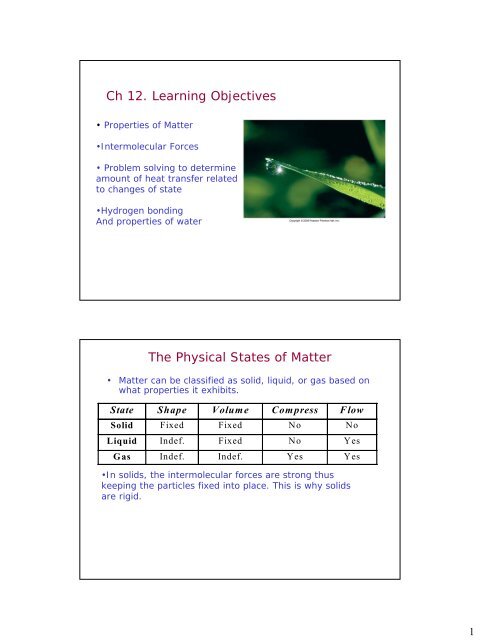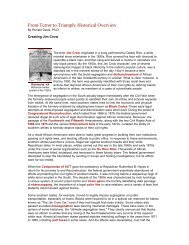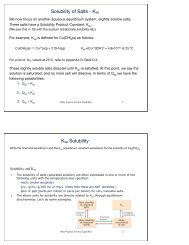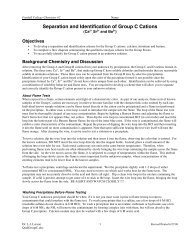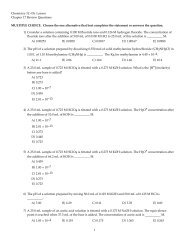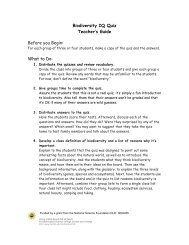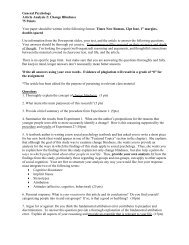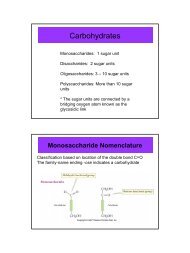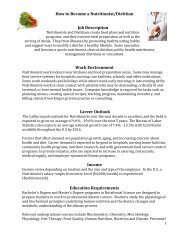Ch 12. Learning Objectives The Physical States of Matter
Ch 12. Learning Objectives The Physical States of Matter
Ch 12. Learning Objectives The Physical States of Matter
Create successful ePaper yourself
Turn your PDF publications into a flip-book with our unique Google optimized e-Paper software.
<strong>Ch</strong> <strong>12.</strong> <strong>Learning</strong> <strong>Objectives</strong><br />
• Properties <strong>of</strong> <strong>Matter</strong><br />
•Intermolecular Forces<br />
• Problem solving to determine<br />
amount <strong>of</strong> heat transfer related<br />
to changes <strong>of</strong> state<br />
•Hydrogen bonding<br />
And properties <strong>of</strong> water<br />
<strong>The</strong> <strong>Physical</strong> <strong>States</strong> <strong>of</strong> <strong>Matter</strong><br />
• <strong>Matter</strong> can be classified as solid, liquid, or gas based on<br />
what properties it exhibits.<br />
State Shape Volume Compress Flow<br />
Solid Fixed Fixed No No<br />
Liquid Indef. Fixed No Yes<br />
Gas Indef. Indef. Yes Yes<br />
•In solids, the intermolecular forces are strong thus<br />
keeping the particles fixed into place. This is why solids<br />
are rigid.<br />
1
In liquids, the particles can move about somewhat freely<br />
as allowed by the intermolecular forces. Liquids do not have<br />
a fixed shape but they are non-compressible, i.e they have a<br />
definite volume.<br />
Properties and Attractive Forces<br />
Phase Density Shape Volume<br />
Relative<br />
strength <strong>of</strong><br />
attractive<br />
forces<br />
Gas Low Indefinite Indefinite Weakest<br />
Liquid High Indefinite Definite Moderate<br />
Solid High Definite Definite Strongest<br />
2
Melting<br />
<strong>Physical</strong> <strong>Ch</strong>anges <strong>of</strong> <strong>Matter</strong><br />
• Generally, we convert a material in the solid state into a liquid<br />
by heating it.<br />
• Adding heat energy increases the amount <strong>of</strong> kinetic energy <strong>of</strong><br />
the molecules in the solid.<br />
• Eventually, they acquire enough energy to partially overcome<br />
the attractive forces holding them in place.<br />
• This allows the molecules enough extra freedom to move<br />
around a little and rotate.<br />
Boiling<br />
•Generally, we convert a material in the liquid state into a gas<br />
by heating it.<br />
•Adding heat energy increases the amount <strong>of</strong> kinetic energy <strong>of</strong><br />
the molecules in the liquid.<br />
•Eventually, they acquire enough energy to completely<br />
overcome the attractive forces holding them together.<br />
•This allows the molecules complete freedom to move around<br />
and rotate.<br />
Dynamic Equilibrium and Vapor Pressure<br />
Dynamic equilibrium is reached when the rate <strong>of</strong> forward reaction<br />
equals the rate <strong>of</strong> reverse reaction.<br />
Vapor pressure <strong>of</strong> liquids is the sum <strong>of</strong> pressures exerted by<br />
individual molecules <strong>of</strong> a substance on the surface <strong>of</strong> the liquid.<br />
In dynamic<br />
equilibrium<br />
Q: What are the effects <strong>of</strong> temperature and surface area <strong>of</strong> a liquid ?<br />
3
Boiling point<br />
Boiling point is the temperature at which the vapor pressure <strong>of</strong> liquids<br />
equals the atmospheric pressure. Also known as the normal boiling<br />
point. (at 1 atm).<br />
How is boiling point affected with altitude?<br />
What will happen if we continuously<br />
supply heat to a boiling liquid?<br />
Trivia:<br />
Water boils at 68 o C on Mount<br />
Everest.<br />
Melting point<br />
Melting point occurs at the temperature at which the solid and<br />
liquid phases <strong>of</strong> a substance are in dynamic equilibrium.<br />
H 2 O (s) H 2 O(l). Endothermic process.<br />
When considered as the temperature <strong>of</strong> the reverse change from<br />
liquid to solid, it is referred to as the freezing point.<br />
Trivia:<br />
In organic chemistry Carnelley’s Rule established in 1882 by<br />
Thomas Carnelley, states that high molecular symmetry is<br />
associated with high melting point. He based his rule on<br />
examination <strong>of</strong> 15,000 chemical compounds !!!<br />
4
Heats <strong>of</strong> Vaporization & Fusion<br />
temp. continues to rise<br />
till entire mass <strong>of</strong><br />
H 2 O reaches b.p<br />
(∆H vap )<br />
ice<br />
Liq. water<br />
m.p <strong>of</strong> H 2 O<br />
Water vapor<br />
b.p <strong>of</strong> H 2 O<br />
temp. continues to rise till<br />
entire mass <strong>of</strong> H 2 O(s) is liquid.<br />
(∆H fusion )<br />
5
Molar heat <strong>of</strong> vaporization is the quantity <strong>of</strong> heat energy needed<br />
to convert 1 mol <strong>of</strong> a liquid to its vapor phase. In kJ/mol.<br />
Vaporization and evaporation are endothermic processes.<br />
Liquid<br />
Water<br />
Isopropyl<br />
alcohol<br />
Acetone<br />
Diethyl<br />
ether<br />
Heats <strong>of</strong> Vaporization <strong>of</strong> Liquids<br />
at <strong>The</strong>ir Boiling Points and at 25 °C<br />
<strong>Ch</strong>emical<br />
formula<br />
H 2O<br />
C 3H 7OH<br />
C 3 H 6 O<br />
C 4H 10O<br />
Normal<br />
boiling<br />
point, °C<br />
100<br />
82.3<br />
56.1<br />
34.5<br />
Tro's Introductory <strong>Ch</strong>emistry,<br />
<strong>Ch</strong>apter 12<br />
∆H vap at<br />
boiling<br />
point,<br />
(kJ/mol)<br />
+40.7<br />
+39.9<br />
+29.1<br />
+26.5<br />
∆H vap at<br />
25 °C,<br />
(kJ/mol)<br />
+44.0<br />
+45.4<br />
+31.0<br />
+27.1<br />
Molar heat <strong>of</strong> fusion (∆Hfus)is the quantity <strong>of</strong> heat needed to change<br />
1 mol <strong>of</strong> a solid to its liquid. (In kJ/mol)<br />
In general, ∆H vap > ∆H fus because vaporization requires<br />
breaking all attractive forces.<br />
Heats <strong>of</strong> Fusion <strong>of</strong> Several Substances<br />
Liquid<br />
Water<br />
Isopropyl alcohol<br />
Acetone<br />
Diethyl ether<br />
<strong>Ch</strong>emical<br />
formula<br />
H 2 O<br />
C 3 H 7 OH<br />
C 3H 6O<br />
C 4H 10O<br />
Tro's Introductory <strong>Ch</strong>emistry,<br />
<strong>Ch</strong>apter 12<br />
Melting<br />
point, °C<br />
0.00<br />
-89.5<br />
-94.8<br />
-116.3<br />
6.02<br />
5.37<br />
5.69<br />
7.27<br />
50<br />
36<br />
∆H fusion,<br />
(kJ/mol)<br />
6
Surface Tension<br />
•Molecules in the interior <strong>of</strong> a<br />
liquid experience attractions to<br />
surrounding molecules in all<br />
directions.<br />
•However, molecules on the<br />
surface experience an imbalance<br />
in attractions, effectively pulling<br />
them in.<br />
•To minimize this imbalance and<br />
maximize attraction, liquids try to<br />
minimize the number <strong>of</strong><br />
molecules on the exposed surface<br />
by minimizing their surface area.<br />
•Stronger attractive forces<br />
between the molecules = larger<br />
surface tension.<br />
Interesting Facts about Surface Tension<br />
Water has the highest surface tension among common liquids<br />
(mercury is higher).<br />
when you look at a glass <strong>of</strong> water, the water "rises" where it touches<br />
the glass (the "meniscus").<br />
Plants are happy that water has a high surface tension because they<br />
use capillary action to draw water from the ground up through their<br />
roots and stems.<br />
7
Viscosity<br />
•Some liquids flow more easily<br />
than others.<br />
•<strong>The</strong> resistance <strong>of</strong> a liquid’s flow<br />
is called viscosity.<br />
•<strong>The</strong> stronger the attractive<br />
forces between the molecules, the<br />
more viscous the liquid is.<br />
•Some liquids are more viscous<br />
because their molecules are long<br />
and get tangled in each other,<br />
causing them to resist flowing<br />
Effect <strong>of</strong> the Strength <strong>of</strong> Intermolecular<br />
Attractions on Properties<br />
• <strong>The</strong> stronger the intermolecular attractions are, the<br />
more energy it takes to separate the molecules.<br />
• Substances with strong intermolecular attractions have<br />
higher boiling points, melting points, and heat <strong>of</strong><br />
vaporization; they also have lower vapor pressures.<br />
8
Hydrogen Bonding<br />
• HF, or molecules that have OH<br />
or NH groups have particularly<br />
strong intermolecular<br />
attractions.<br />
– Unusually high melting and<br />
boiling points.<br />
– Unusually high solubility in<br />
water.<br />
• This kind <strong>of</strong> attraction is called a<br />
hydrogen bond.<br />
Name Formula<br />
Properties and H-Bonding<br />
Molar<br />
mass<br />
(g/mol)<br />
Structure<br />
H<br />
Boiling<br />
point,<br />
°C<br />
Melting<br />
point,<br />
°C<br />
Solubility<br />
in water<br />
Ethane C 2 H 6 30.0 -88 -172 Immiscible<br />
H C<br />
H<br />
H<br />
C H<br />
Ethanol CH4O 32.0 H C O H<br />
64.7 -97.8 Miscible<br />
H<br />
H<br />
H<br />
9
Hydrogen Bonding<br />
• When a very<br />
electronegative atom is<br />
bonded to hydrogen, it<br />
strongly pulls the bonding<br />
electrons toward it.<br />
• Since hydrogen has no<br />
other electrons, when it<br />
loses the electrons, the<br />
nucleus becomes<br />
deshielded.<br />
– Exposing the proton.<br />
• <strong>The</strong> exposed proton acts as<br />
a very strong center <strong>of</strong><br />
positive charge, attracting<br />
all the electron clouds from<br />
neighboring molecules.<br />
H-Bonds vs. <strong>Ch</strong>emical Bonds<br />
• Hydrogen bonds are not chemical bonds.<br />
• Hydrogen bonds are attractive forces between<br />
molecules.<br />
• <strong>Ch</strong>emical bonds are attractive forces that make<br />
molecules.<br />
10
Practice Problems In Class<br />
1. You put 1.00 L <strong>of</strong> water (4 cups) in a pan at 100 o C<br />
And the water evaporates. How much heat must have been<br />
supplied to vaporize the water? ∆H vap at 100 o C = 40.6 kJ/mol<br />
Ans: 2.26 X 10 3 kJ<br />
2. Calculate amount <strong>of</strong> water in g that can be vaporized at its b.p<br />
with 155 kJ <strong>of</strong> heat? Ans: 68.6 g<br />
3.What is the energy required to melt 81.1 g <strong>of</strong> ice at<br />
0 °C? <strong>The</strong> molar heat <strong>of</strong> fusion <strong>of</strong> water is 6.02 kJ/mol.<br />
∆H fus at 0 o C = 6.02 kJ/mol ANS: 27.1 kJ<br />
(ice has negative calories)<br />
4. An 8.5 g <strong>of</strong> ice cube is placed into 255 g <strong>of</strong> water.<br />
Calculate the temperature change <strong>of</strong> water in complete<br />
melting <strong>of</strong> the ice? (<strong>12.</strong>89)<br />
5. How much heat in kJ is evolved in converting 1.00 mol <strong>of</strong> steam<br />
At 145 C to ice at –50 C? Heat capacity <strong>of</strong> steam = 1.84 J/g. o C<br />
And <strong>of</strong> ice is 2.09 J/g o C (<strong>12.</strong>93)<br />
5. Which <strong>of</strong> the following has the least solubility in<br />
water? And why?<br />
1. CH 3 CH 2 CH 3<br />
2. CH 3 CH 2 NH 2<br />
3. CH 3 OCH 3<br />
4. H 2 O<br />
5. CH 3 CH 2 OH<br />
<strong>Ch</strong>eck for this is in the review<br />
worksheet handed out in<br />
Class for <strong>Ch</strong> 12,13 and 14<br />
11
6. Which <strong>of</strong> the following high boiling point? And<br />
why?<br />
1. CH 3 CH 2 CH 3<br />
2. CH 3 CH 2 NH 2<br />
3. CH 3 OCH 3<br />
4. CH 4<br />
5. CH 3 CH 2 OH<br />
<strong>Ch</strong>eck for this is in the review worksheet handed out in<br />
Class for <strong>Ch</strong> 12,13 and 14<br />
‘Unusual’ properties <strong>of</strong> water<br />
Water is unique in that it is the only natural substance<br />
that is found in all three states, liquid, solid (ice), and<br />
gas (steam) at the temperatures normally found on<br />
Earth.<br />
Water becomes less dense upon freezing.<br />
This results in an unusual phenomenon: water's solid form, ice,<br />
floats upon water, allowing organisms to survive inside a<br />
partially-frozen water body.<br />
12
‘Unusual’ properties <strong>of</strong> water<br />
Water has a high specific heat index. This means that water can<br />
absorb a lot <strong>of</strong> heat before it begins to get hot.<br />
•is valuable to industries and in car radiators as a coolant.<br />
•helps regulate the rate at which air changes temperature,<br />
which is why the temperature change between seasons is gradual<br />
rather than sudden, especially near the oceans.<br />
Water has a very high surface tension.<br />
In other words, water is sticky and<br />
elastic, and tends to<br />
clump together in drops.<br />
Hydrogen bonding<br />
between water molecules<br />
13


